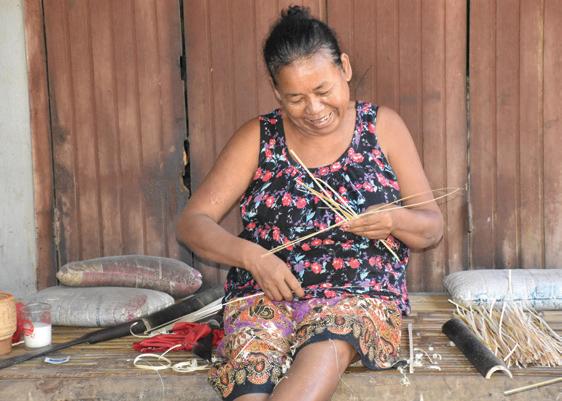
5 minute read
Southern Laos
A MAGICAL RETREAT FROM THE MODERN WORLD

Advertisement












TEXT BY ROSEMARY MURPHY & BOUNPONE VANNAPHONE PHOTOGRAPHS BY SWISSCONTACT

Water buffalo wallow in the mud while farmers harvest sticky rice by hand, the way they have for hundreds of years. Roadside stands are laden with fresh coconuts and watermelons. Towering palms and sprawling rain trees line the Mekong River; its surface dotted with long, colorful, wooden boats. Before we’ve even reached what was once the seat of the Kingdom of Champasak my body relaxes, absorbing the super-saturated hues of the countryside.
Entering Champasak town, I eye the guesthouses and restaurants, their shady, riverside decks lush with green foliage. We set out from Wat Luang Kao, a vibrantly beautiful temple, to follow a shady dirt trail that winds its way along the river bank through a few of the 9 villages that make up Champasak today. It’s hidden from the main road and feels worlds away from modern life. Among the traditional wooden houses on stilts, we catch intimate glimpses of locals’ daily lives – a man washing his hair at an outdoor sink, a family picnicking in a bamboo grove, a man mending fi shing nets. A couple on a scooter whiz by with a large Mekong river fi sh swinging behind them. A line is hung with strips of buffalo skin to make Laostyle jerky. Two women are splitting bamboo, and an old woman deftly weaves the strips into a basket for sticky rice. In a clearing, large translucent discs of hand-made rice noodles dry on bamboo screens in the midday sun.
We explore Wat Meuang Kang, the oldest active temple in Champasak, built in the 19th century and fusing several architectural styles, and then stop in at a nearby house to experience Lao cooking. I’m handed an apron and ushered into a traditional Lao kitchen. Our host Mik is warm and friendly and puts me to work with a large wooden mortar and pestle. I pound fi ery red chilies, garlic, and tomatoes into a paste. We add strips of green papaya, fresh lime, and dark and funky fermented fi sh sauce, padaek, for a papaya salad. Little round eggplants, roasted until meltingly soft, are pounded with sesame seeds and dried chilies to create a baba ganoush-like dish, topped with cilantro and green onions from Mik’s kitchen garden.
I’m full but buoyed by the morning’s experiences, and I notice even the air here feels charged with a different energy. I’m not surprised that this plain between the Mekong and the mountains has been considered sacred for well over a thousand years. You can cycle along the Ancient Khmer road, originally linking India to Cambodia, and fi nd the earthen walls of an ancient city. Dating back to the 5th century, it is believed to be the oldest urban settlement in

Southeast Asia. And then there is the undeniable magic of a golden hour visit to Wat Phou.
Soulivanh Phounthareungsy fell in love with the carvings of fantastical deities adorning the temple’s tilted lintels. He taught himself to sculpt and fi re clay so that he might recreate them in his Champasak Pottery studio. He is probably the only sculptor currently working in this style in Laos. His enthusiasm for Champasak, its culture, its people, and their way of life, is contagious. Before we head for dinner, we pop out back to see the large, handmade earthen kiln. Behind it rice fi elds and Phou Kao mountain where the sun is setting over Wat Phou. “It’s always been a special place,” he says.
In the evening, Champasak is even more enchanting. The warm glow of woven lanterns illuminate tureens of Mekong fi sh soup perfumed with lemongrass, spicy laap, and baskets of sticky rice. The magic that compelled people to settle here a thousand years ago appears to be alive and well today.

GETTING THERE Lao Airlines fl ies regularly to Pakse from Vientiane, Luang Prabang, Bangkok, and Siem Reap. Champasak town is 40km south of Pakse.
1. Soulivanh sculpts a Khmer fi gurine 2. Wat Phou 3. A cheerful villager weaves bamboo 4. A colorful Naga staircase 5. Mr. Tiger guides a guest in Champasak
2




1

EXPERIENCE CHAMPASAK Book a guide for one of Wat Phou and Champasak’s Heritage and Archaeology Trails: Mr. Bouasone Phommaboud, Champasak Tourism Information Centre +856 (0)30 09 23 96 73 Mr. Soubanh Kanhaphanh, Vat Phou Museum +856 (0)20 55 76 92 21 information@vatphou-champassak.com vatphou-champassak.com
Book a walking tour of Champasak Village Life with Mr. Tiger: thanaphone@laogo-carrental.com
BOUN WAT PHOU Wat Phou festival, one of the largest festivals in Laos, attracts thousands of people each year for 3 days and nights of celebration including prayer ceremonies, almsgiving, and traditional games, music, and dancing. This year the festival will be held on Feb 07–09. See more at vatphou-champassak.com


3
5







4

逃离现代世界奇妙旅程 翻译 : 尹航 图片来源: SWISSCONTACT / BART VERWEIJ
进入占巴塞镇,沿河可见一些旅馆和餐馆。我们从充满活力的美丽 寺庙Wat Langang Kao出发,沿着一条沿河的泥泞小路穿过今天 组成占巴色省的9个村庄的几个。它们不在主干道上,远离现代生 活。在传统的高跷木屋中,我们可以窥见当地人的日常生活-一个男 人在室外的水槽里洗头,一家人在竹林里野餐,一个男人在修补渔 网。一对情侣在躺着秋千,身后挂着一张大大的捕鱼网。一条线上 悬挂着水牛皮条用来制作老式肉干。两个女人正在劈竹子,一个老 妇人灵巧的编制着承装糯米饭的竹篮。正午,在一片空旷的区域, 手工制作的半透明米粉片儿正在竹帘上晾晒。 我们将探索建于19世纪,融合多种建筑风格的占巴塞最古老的庙 宇Wat Meuang Kang,然后在附近的居民处体验老挝的烹饪。 我穿上围裙,走进传统的老挝厨房。接待我们的主人Mik热情友 好,她递给我们一个大大的木质研钵和杵。我将红辣椒,大蒜和 西红柿扔进研钵内,捣成糊状。再加入青木瓜,新鲜柠檬汁和鱼露 (padaek),青木瓜沙拉就只制作好了。圆形的小茄子烤至变软, 然后用芝麻籽和干辣椒捣碎,制成蘸酱,上面撒上Mik自家花园里 种植的香菜和葱。 我吃的很饱,而这个清晨让我神清气爽,甚至觉得这里的空气也充 满了不同的能量。湄公河和高山之间的这块平原被一千多年来都 被视为神圣的之地,这点我并不感到惊讶。您可以沿着古老的高棉 道路骑行,该道路最初将印度与柬埔寨连接起来,并最终抵达一座 古老城市的土墙。它可以追溯到5世纪,被认为是东南亚最古老的 城市居住区。然后,不可否认的是,参观Vat Phou庙的一个小时印 象深刻。 到了晚上,占巴塞更加迷人。灯笼的柔光撒进桌上的柠檬草湄公河 鱼汤,辛辣Larb和糯米饭的篮子里。一千年前吸引人们来此定居的 魔力似乎还在,并且今天看起来更有魅力了。 到达: 老挝航空定期从万象,琅勃拉邦,曼谷和暹粒出发飞往巴色。占巴塞镇 位于巴色以南40公里处。










